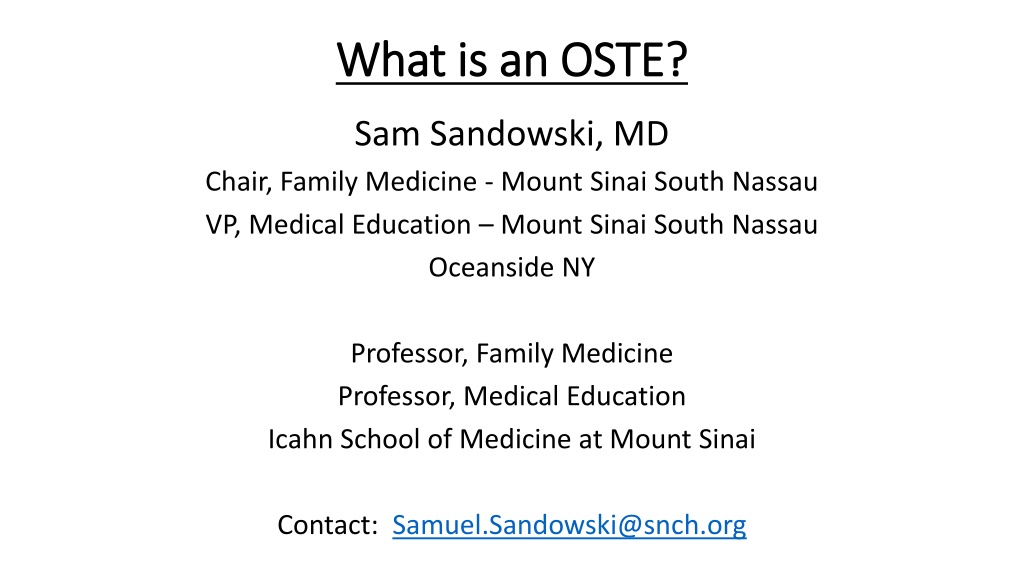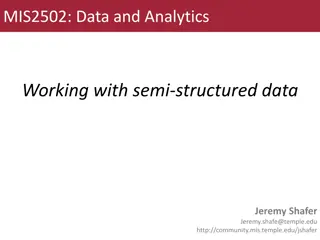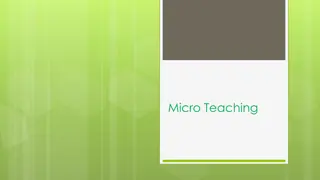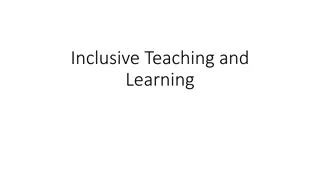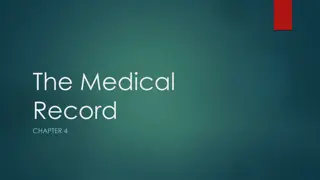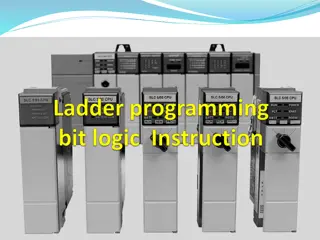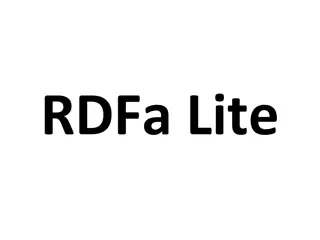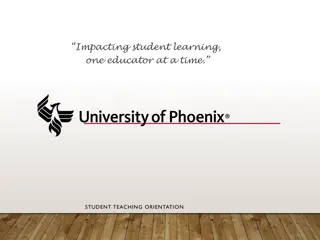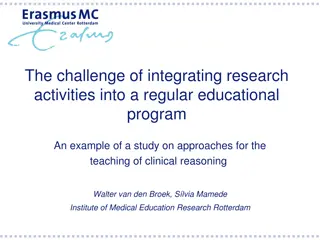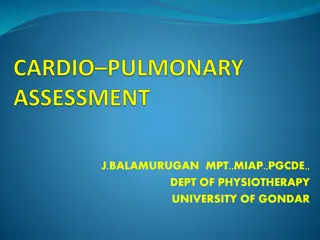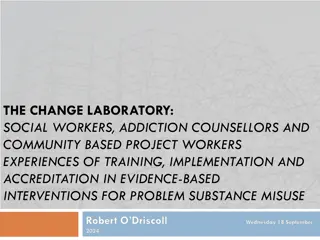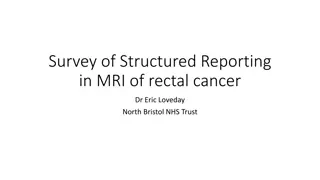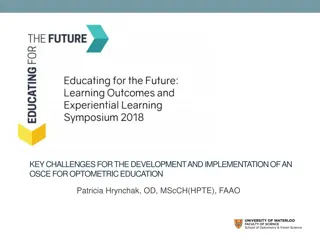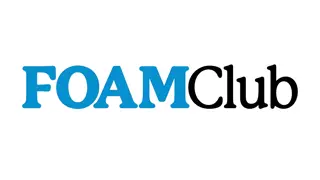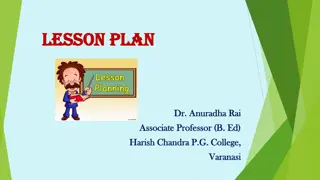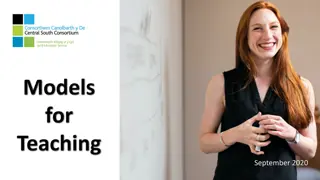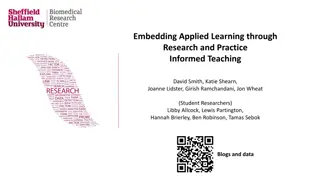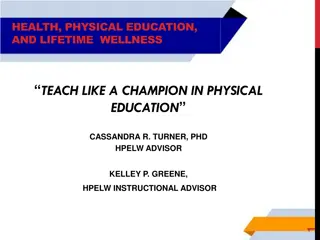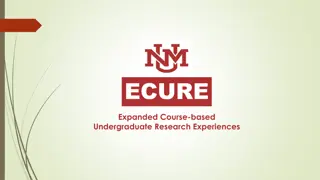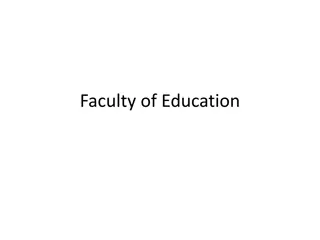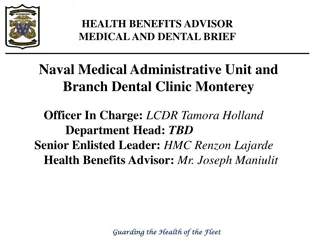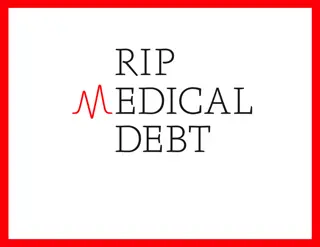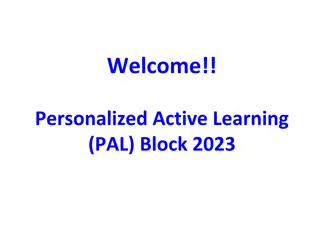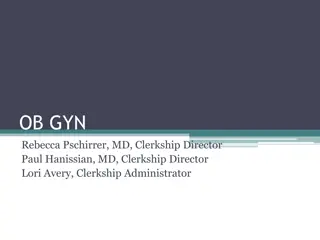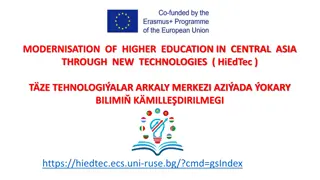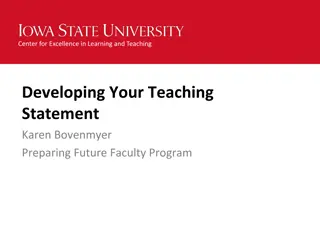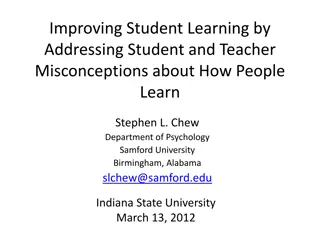Implementing Objective Structured Teaching Experiences (OSTEs) in Medical Education
The use of Objectives Structured Teaching Experiences (OSTEs) is explored as a teaching tool in medical education to provide formative feedback to faculty without grading, enhancing competency-based education. Challenges, plans, logistics, and scenarios for implementing OSTEs are discussed, emphasizing the importance of faculty development.
Download Presentation

Please find below an Image/Link to download the presentation.
The content on the website is provided AS IS for your information and personal use only. It may not be sold, licensed, or shared on other websites without obtaining consent from the author. Download presentation by click this link. If you encounter any issues during the download, it is possible that the publisher has removed the file from their server.
E N D
Presentation Transcript
What is an OSTE? What is an OSTE? Sam Sandowski, MD Chair, Family Medicine - Mount Sinai South Nassau VP, Medical Education Mount Sinai South Nassau Oceanside NY Professor, Family Medicine Professor, Medical Education Icahn School of Medicine at Mount Sinai Contact: Samuel.Sandowski@snch.org
What is an OSTE? Similar to an OSCE Not graded Formative Feedback Observed Structured Teaching Experience
The Premise The ACGME requires all faculty to participate in faculty development annually. The use of standardized patients and Objective Structured Clinical Examinations (OSCEs) are common in medical education. The use of Objective Structured Teaching Experiences (OSTEs), though documented 30 years ago, is still not a commonly used teaching tool. Education, assessments, and evaluations are becoming more competency based.
The Challenge Physician faculty have often been reluctant to being observed or recorded during real patient encounters. Using a controlled OSTE, with one-on-one feedback from faculty development experts allows formative feedback without being graded or liable Need time, space, equipment, personnel Need faculty development specialists
The Plan To create and implement OSTEs and take it a step further. All core faculty (N=7) were required to participate. Faculty and standardized resident provided feedback on the faculty s performance for each scenario. After each scenario, there was immediate feedback from the faculty development specialist. After all scenarios occurred, there was a debrief with the entire faculty cohort After debriefing each faculty completed a questionnaire about their experience and each faculty member picked one area they wish to improve over the next few weeks. After 3 weeks, each faculty member presented on their area of improvement.
Logistics Time needed for residents to learn the patient for faculty to have the OSTE for debrief for faculty development 3-4 weeks later Equipment needed smart phones or laptops Office space needed clinic space, when clinic was not being used
The How Three OSTE scenarios were created; the resident who cannot present in a concise and comprehensive way; the resident who seems more interested in finishing the patient encounter than caring for the patient; the resident who has excellent medical knowledge but does not know how to manage time and patient flow. Residents were taught how to play the role of the standardized resident. Resident prep included hour of letting them know the expectations and presenting them with the scenarios. Each resident played only 1 standardized resident Resident commitment was 3.5 hours on the day of the OSTE
Timing Each encounter was to last a maximum of 7 minutes After each encounter, residents completed an assessment tool on how the faculty controlled the learning environment; the faculty completed the same assessment tool for self assessment. (3 minutes) The faculty development moderator observed each encounter in real time via facetime / teams / skype, and after each encounter debriefed with each faculty member for up to 10 minutes, reviewing the videos of the encounters in the process. After all 7 faculty encountered all 3 scenarios, the group met, debriefed about the process, and each faculty member self-selected one of the 8 elements used on the scoring system to self-improve and present at a subsequent faculty meeting.
The Schedule Resident 1 Resident 2 Resident 3 8:00 Faculty 1 Faculty 2 8:20 Faculty 1 Faculty 2 8:40 Faculty 2 Faculty 3 9:00 Faculty 4 Faculty 1 9:20 Faculty 3 Faculty 4 9:40 Faculty 4 Faculty 3 10:00 Faculty 5 Faculty 6 10:20 Faculty 5 Faculty 6 10:40 Faculty 7 Faculty 5 11:00 Faculty 6 Faculty 7 11:20 Faculty 7 11:40 12:00 Group Debrief
Case 1: Resident who cannot present in a concise fashion Resident continually looks at phone and checks it during the encounter 43 year old male who presents with hip pain. I want to get an MRI to r/o sacroiliitis and give him NSAIDS. On exam he has limited range of motion with a positive faber test. He was limping when he came into the room. The patient has a history of DM and Hypertension, but those are well controlled. He has a family history of Ewings sarcoma, but he doesn t have any bone problems. He has been having this pain for about 1 week, and it s been worse over the last 2 days. Maybe we should consider injecting the hip and get an US? He takes Metformin and Amlodipine. I don t know if he is taking anything for pain. The pain is in the hip and radiates down the buttock. No nausea, vomiting, diarrhea, fever, cough, nasal congestion or headache. What else would you like to know?
Case 2: Resident who is more interested in finishing the patient encounter than caring for the patient t I have a patient with a headache. I didn t find any major neuro deficits, so I want to treat with NSAID s. Upon further questioning, it can be revealed that the patient has the following: Worst headache ever (but resident states had headaches in the past ); Headache started suddenly about 3 hours earlier and has been getting worse. Tried Tylenol no relief (it usually helps with other headaches). Very nauseated, but no vomiting. No fever. c/o Pain above eyes; Stiff neck; Sensitive to light; No vision loss, but blurred Age 76, smoker; + hx of uncontrolled htn; VS P 105, RR 18, BP 170/100, T 99.0 Pupils asymmetric, no lid lag; No facial asymmetry Ears / nose / throat unremarkable; Neck supple no JVD, no nodes, no bruits Heart tachy, regular, no mur, S1 and S2 normal; Lungs clear; Abd benign Extr no motor or sensory deficits. ALL SX MINIMIZED BY THE RESIDENT. Resident does not want to get imaging, Just wants to send pt to home on NSAID and follow up next day to see how they re doing (in terms of headache and BP). Resident mentions that he is anxious to finish so he can get to the hospital, as he is on call that evening.
Case 3: Resident with excellent medical knowledge who is challenging the attending / not considering patient flow I have a 59 year woman with HTN, DM and hypothyroidism all for about 25 years. She presents for routine screening and has no complaints. For her DM, she sees ophthalmology regularly, and checks her glucose at least twice daily. Readings are about 90 fasting and 130 post prandial. She is on insulin and metformin, watches her diet, and exercises daily for 30 minutes. For her HTN, her BP is checked at home, and is usually 135/85 and she is on Amlodipine 5 mg daily and Enalapril 10 mg daily. She has no overt symptoms of hypo or hyperthyroidism and takes thyroxine 100 mcg daily. The patient works as a teacher, smokes 1 pack per day, and drinks 1-2 glasses of wine with dinner. Her most recent bloodwork was 3 months ago, and everything was WNL, including CBC, CMP, TSH, HgbA1c, lipid profile, and urine for microalbumin. Her vital signs are stable, and her physical exam is unremarkable. She feels and looks great.
Case 3 - continued: Resident with excellent medical knowledge who is challenging the attending / not considering patient flow Today, we need to do the following: 1. Start her on ASA 2. Start her on a statin 3. Order a Dexa scan 4. Order a well woman exam last 2 years ago, and the first one in 10 years 5. Order a colonoscopy she never had one 6. Council her on her new medications 7. Order an HIV test as she never had one before. (No, she isn t sexually active and doesn t use illicit drugs, but it s recommended) 8. Order a Hepatitis C cause she falls into the screening group 9. Counsel her on smoking cessation 10. Counsel her on decreased alcohol consumption because she is high risk with the amount she drinks 11. Send her to ophthalmology for her yearly check up I know I have 2 other patients waiting for me, but I need to do all these things because they are recommended.
The Assessment Tool After the encounter, both the attending and standardized resident completed a scoring sheet of 8 elements: (1) listening by the preceptor how well did the attending listen before they spoke? (2) guidance by the preceptor did the preceptor help guide the resident make a more precise presentation? (3) teaching pearls did the preceptor provide teaching pearls towards diagnosis or management? (4) suggestions for further reading - any suggestions made for supplemental reading? (5) providing feedback was positive and negative feedback provided? (6) controlling the learning environment - did the preceptor set expectations and guide the resident if they seemed to deviate in terms of professionalism, communication, expectations? (7) allowing for resident self-assessment was time for self reflection provided? Encouraged? (8) overall professionalism displayed by attending how professional was the preceptor towards the encounter? Each element was scored on a scale of 1-5, with 5 being the most proficient. Since there were 3 scenarios, there was a maximum of 15 points for each element.
Average Attending and Resident Scores of Precepting Elements 16 14 12 10 8 6 4 2 0 Listening Guidance Teaching Pearls Suggesting Reading Feedback Controlling the Learning Environment Self Reflection Professionalism -2 Average Attending Score Average Resident Score Difference
Overall Scores of Precepting Encounter 120 100 80 60 40 20 0 Attending 1 Attending 2 Attending 3 Attending 4 Attending 5 Attending 6 Attending 7 Attending Self Score Resident Score Difference in Score
Feedback From Attending Overall did you find the OSTE useful? 1, 2, 3, 4, 5 Did you think the resident who couldn t present well was realistic? 1, 2, 3, 4, 5 Did you think the resident who wanted to address everything was realistic? 1, 2, 3, 4, 5 Did you think the resident who was more interested in finishing than patient care was realistic? 1, 2, 3, 4, 5 Please choose 2 areas you would like to read more about and present at a faculty meeting. You will only be asked to present on one of them, but we ask that you choose 2, so we can cover as many of these topics as possible. The presentation will only be 5-10 minutes, and occur in about 1 month: 1. Listening and attentiveness of preceptors 2. Guidance by preceptors 3. Delivering Teaching Pearls while precepting 4. Suggestions for further reading and assignments as part of precepting 5. Provide feedback: 6. Controlling the learning environment: 7. Permitting for resident self-reflection 8. Professionalism by attendings
OSTE Inspiring Faculty Development - Articles Presented / Referenced Reflection in medical education: intellectual humility, discovery, and know-how SHOW AND TELL; CONTeMPLATE a mnemonic to help medical educators infuse reflection into their residency curriculum The reflective zombie: Problematizing the conceptual framework of reflection in medical education How Educators Conceptualize and Teach Reflective Practice: A Survey of North American Pediatric Medical Educators Guidelines for Resident Teaching Experiences (ACCP White Paper) Becoming a super preceptor: A practical guide to preceptorship in today's clinical climate Teaching the One minute Preceptor: A Randomized Controlled Trial Integrating Precepting Into Your Daily Practice Precepting skills for precepting challenges Precepting 101: Teaching Strategies and Tips for Success for Preceptors
